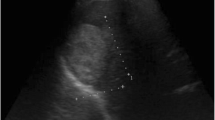Abstract.
With a cavernous hemangioma the vascular space does not form an anastomosis, and the blood flow is slow. In contrast, several atypical hemangiomas, including those with shunt formation, have been recently recognized. We report here two extreme cases of atypical hemangioma with severe clinical symptoms due to shunts. In the first case, hemangiomatosis of the entire liver with arteriovenous shunt was treated by embolization of the hepatic artery with as many as 82 steel coils to control high-output heart failure. Although the effect of the treatment was late, the patient is free from heart failure despite a remnant arteriovenous shunt 12 years after treatment. In the second case, an atypical hemangioma in the posterior segment with arterioportal and portosystemic shunt was treated by ligation of the right hepatic artery and the portal vein branch. The patient died of massive bleeding from a deep duodenal ulcer that penetrated the hepatic artery 6 years after treatment. The second case should have been curatively treated only by liver transplantation. It should be noted that there are atypical hemangiomas with shunt that are difficult to treat and cause fatal clinical symptoms and complications.
Similar content being viewed by others
Author information
Authors and Affiliations
Additional information
Received: March 31, 2002 / Accepted: June 17, 2002
Offprint requests to: A. Tanaka Maizuru Municipal Hospital, 150-11 Aza-Mizojiri, Maizuru, Kyoto 625-0035, Japan
About this article
Cite this article
Tanaka, A., Morimoto, T., Yamamori, T. et al. Atypical liver hemangioma with shunt: long-term follow-up. J Hep Bil Pancr Surg 9, 750–754 (2002). https://doi.org/10.1007/s005340200104
Issue Date:
DOI: https://doi.org/10.1007/s005340200104




